Tuesday, October 22, 2013
Dec. 16: Kennedy Scholarship deadline
2013 SPX video interviews
Monday, October 21, 2013
Brian Biggs' brand new book Everything Goes: By Sea
Lion King theater article in today's Express
Swann Foundation accepting fellowship applications
NPR interviews Scott 'Dilbert' Adams
TALKIN' 'BOUT TOONS Panel Discussion | Monday, 21 October 2013
TALKIN' 'BOUT TOONS Panel Discussion | Monday, 21 October 2013
DATE: Monday, October 21
TIME: 7:30 - 9 p.m.LOCATION: Northern Virginia Community College, Alexandria, Va, Tyler Building | AA-270
Join us for an informative panel discussion moderated by NOVA's Rachel Martin and Chris Choi with the following cartoon artists:
Marty Bauman
Artist at Pixar Animation Studios, and illustrator for Disney on such films as Toy Story 3 and Cars 2.
Steve Conley
Award-winning cartoonist, designer and co-creator of Comicon.com. His comics work includes Star Trek: Year Four, Michael Chabon's Escapist and his own self-published Astounding Space Thrills.
Kevin Rechin
Editorial cartoonist for USA Today, National Geographic, and the Wall Street Journal among others.
Matt Wuerker
POLITICO's editorial cartoonist and the winner of the 2012 Pulitzer Prize for editorial cartooning.
Tyler Gallery, Room AT-270
Current Exhibit: Five Fantastic Cartoon Artists: A Look at Art, Process, Story, and Design
CONTACT:
For more information, contact Lisa Hill ehill@nvcc.edu or Britt Conley bconley@nvcc.edu
Sunday, October 20, 2013
That darn Pearls Before Swine
Letter to the Editor: Holding the line against lazy grammar
Jack Fretwell, Reston
Washington Post October 19 2013http://www.washingtonpost.com/opinions/holding-the-line-against-lazy-grammar/2013/10/18/5c65c570-34ee-11e3-89db-8002ba99b894_story.html
Friday, October 18, 2013
Oct. 20: 5 Centimeters Per Second anime at Freer Gallery
| ||||||||||||||||
NPR on Afterlife with Archie; local variant editions to collect

Oct 21-22: Brian Biggs booksignings
Thursday, October 17, 2013
Bleeding Cool has a Washington, DC correspondent, who interviews Nobrow founder
"We Want To Print Books That Deserve To Be Printed" – The Bleeding Cool Interview With Nobrow Co-Founder Alex Spiro
October 15, 2013
http://www.bleedingcool.com/2013/10/15/we-want-to-print-books-that-deserve-to-be-printed-the-bleeding-cool-interview-with-nobrow-co-founder-alex-spiro/
David Dissanayake, our Washington DC Correspondent, interviews Nobrow co-founder Alex Spiro shortly after their New York office opening.
MSU Libraries reprint classic comic Tim Tyler's Luck
Cicada: Exotic Views by Davy Shian available now
Oct. 23: 'March' writers at Fantom Comics
Wednesday, October 16, 2013
Jeff Smith at this year's SPX video online
Isaac Cates
SmallPressExpo Oct 15, 2013
http://www.youtube.com/watch?v=QoUko1wOuWw
Oct 21: FIVE FANTASTIC CARTOON ILLUSTRATORS panel discussion
| |||||||||
DCist Loves Big Planet Comics
By Sarah Anne Hughes
Oct 16, 2013
http://dcist.com/2013/10/the_11_classic_washington_stores.php
Comic Riffs on Watterson and Thompson, together again
By Michael Cavna
Washington Post Comci Riffs blog October 16 2013
http://www.washingtonpost.com/blogs/comic-riffs/post/calvin-meets-cul-de-sac-bill-watterson-richard-thompson-say-theyre-happy-to-share-new-two-man-osu-show-next-march-dates-announced/2013/10/16/1a3f417c-3547-11e3-80c6-7e6dd8d22d8f_blog.html
Monkey See on Superheroes: A Never-Ending Battle
Oct 17: Seth Goldman at One More Page Books
| |||||||||||||||
Seth Goldman - Mission in a Bottle
Oct. 17, 19: Hondros at Artisphere
Tuesday, October 15, 2013
Local reporting on Syrian cartoonist Akram Raslan
Dr. Robert Russell
10/07/2013
http://www.cartoonistsrights.org/recent_developments_article.php?id=110
Akram Raslan: Rights group clarifies report that Syrian political cartoonist was executed
By Michael Cavna
Washington Post Comic Riffs blog October 13 2013
http://www.washingtonpost.com/blogs/comic-riffs/post/akram-raslan-rights-group-clarifies-report-that-syrian-political-cartoonist-was-executed/2013/10/13/7f0ed88a-3478-11e3-80c6-7e6dd8d22d8f_blog.html#pagebreak
Mark Burrier's New Exhibition: "Chosen" at Frederick Community College
|
Thoughts on Superheroes: A Never Ending Battle part 3 (airing tonight)
Part 3, “A Hero Can Be Anyone” (1978-Present), is largely about how superheroes have moved from being entertainment for children to being popular culture for adults. It opens with highlights from the Avengers movie, noting that it was the third highest grossing movie of all time. The San Diego Comic-Con is visited next, showing plenty of quick interviews with adult cosplayers rather than comic book fans.
 The documentary then steps back to the 1970s and the lack of trust in government due to Richard Nixon. In this telling, the release of Superman: The Movie in 1978 inspired people, especially with its tagline "You'll believe a man can fly." Several comic book writers point out that Christopher Reeves' great dual performance as Clark Kent and Superman, and the use of romantic situations were the thing that made the movie work more than the special effects. Superman: The Movie also led to a campaign to compensate and credit Siegel and Shuster for their creation, and Kantor covers this in some detail.
The documentary then steps back to the 1970s and the lack of trust in government due to Richard Nixon. In this telling, the release of Superman: The Movie in 1978 inspired people, especially with its tagline "You'll believe a man can fly." Several comic book writers point out that Christopher Reeves' great dual performance as Clark Kent and Superman, and the use of romantic situations were the thing that made the movie work more than the special effects. Superman: The Movie also led to a campaign to compensate and credit Siegel and Shuster for their creation, and Kantor covers this in some detail.Meanwhile comic book sales continued to drop (and as noted in my second review, the creation of the direct market is not mentioned here either). Marvel pulled one of the early stunts by having Spider-Man get married, although former Marvel Editor-in-Chief Joe Quesada notes that once you've started time passing, when does it end? Should Spider-Man grow old? It's not mentioned in the film, but Quesada believes not, and retconned Spider-Man's marriage out of existence with a literal deal with the devil.
 Frank Miller's tour-de force Batman: The Dark Knight Returns (1986) is the next highlight, and is held up as the first adult superhero comic book. Comic book and television writer J. Michael Straczynski called the comic book about an aging Batman "the most seminal work in the field today" and I agree. Mark Waid then notes that 1986 saw another seminal work, Alan Moore and Dave Gibbon's Watchmen. Watchmen took the opposite approach to B:TDKR, and looked at the issues of vigilante justice and fascism inherent in superheroes.
Frank Miller's tour-de force Batman: The Dark Knight Returns (1986) is the next highlight, and is held up as the first adult superhero comic book. Comic book and television writer J. Michael Straczynski called the comic book about an aging Batman "the most seminal work in the field today" and I agree. Mark Waid then notes that 1986 saw another seminal work, Alan Moore and Dave Gibbon's Watchmen. Watchmen took the opposite approach to B:TDKR, and looked at the issues of vigilante justice and fascism inherent in superheroes.Marvel's new X-Men pre-dated these two comics, but are introduced next. The multicultural and multiracial cast is held up as a model in which anyone could find a character or situation to relate to. Gay comics artist Phil Jiminez explicitly states the comic was "a most amazing metaphor for young gay people." The similar success of Marv Wolfman and George Perez's New Teen Titans is not mentioned at all however.
 The film segues into the reworking of Spider-Man by artist Todd McFarlane and the subsequent formation of Image Comics by hotshot young enegade artists. McFarlane's interview segments are among the most entertaining in this segment. The Death of Superman is then examined as another highlight drawing media attention, but also as beginning of the bursting of the collectible bubble as people bought multiple copies as investments.
The film segues into the reworking of Spider-Man by artist Todd McFarlane and the subsequent formation of Image Comics by hotshot young enegade artists. McFarlane's interview segments are among the most entertaining in this segment. The Death of Superman is then examined as another highlight drawing media attention, but also as beginning of the bursting of the collectible bubble as people bought multiple copies as investments.Kantor argues that the "grim and gritty era was ending" by this point, which I disagree with, and the film says that 9-11 ended that type of comic story which began in Dark Knight Returns fifteen years earlier. Marvel's 9-11 comic book is shown (although DC's is not), and then the Civil War story line is featured. This long and wide story put superheroes led by Captain America and Iron Man on opposite sides of a government-sponsored initiative to keep track of superheroes. DC's Batman movies directed by Christopher Nolan are also cited as a response to America's post-9-11 angst - convincingly I believe.
The film then circles back to fun and 'sexy' movies such as Spider-Man. Zach Snyder states that such movies are keeping superheroes alive when comic books can't, and Grant Morrison claims that videogames will be the future. The film ends optimistically of course - it's about superheroes.
All 3 parts of the documentary air locally on WETA at 8 pm tonight. Previews and outtakes can be seen on Youtube.
Images courtesy of Grand Comics Database.
The Post reviews ‘Superheroes: A Never-Ending Battle’ which airs tonight
PBS' 'Superheroes: A Never-Ending Battle' shows comics as uniquely American stories
By Michael Cavna,
Washington Post October 15 2013
http://www.washingtonpost.com/lifestyle/style/pbs-superheroes-a-never-ending-battle-shows-comics-as-uniquely-american-stories/2013/10/14/743a9b44-350c-11e3-be86-6aeaa439845b_story.html
Monday, October 14, 2013
Mike's flea market finds, continued
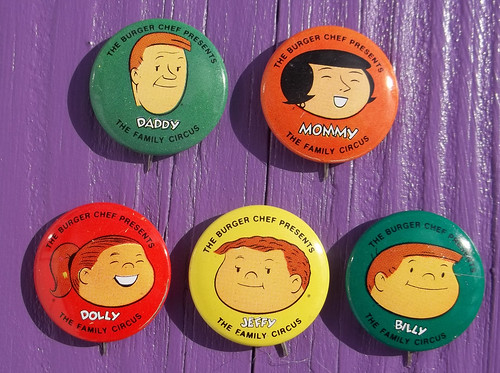
Because everyone needs a set of Family Circus buttons from Burger Chef.
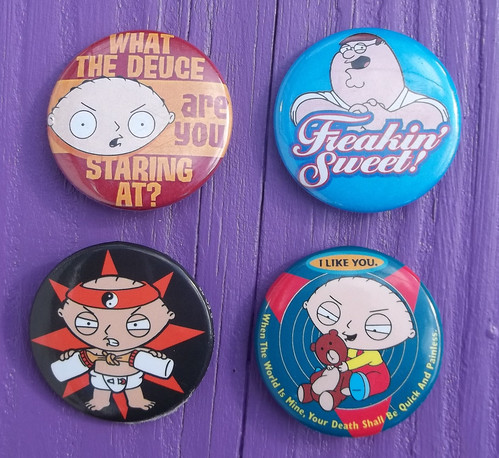
I don't even like Family Guy, but I rescued them from the 6 for $1 bin.
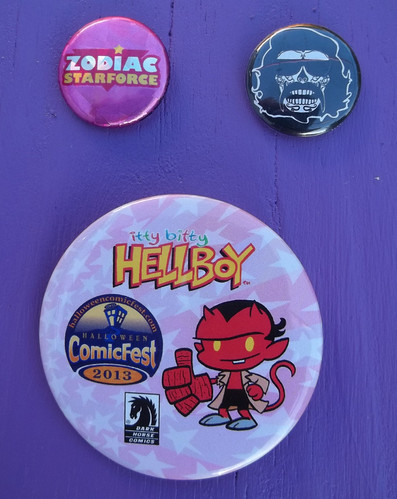
These are all brand-new in 2013. Zodiac Starforce webcomic, animator Raul Aguirre Jr, and Halloween Comicfest 2013 buttons. Zodiac Starforce is done by local creators out of Big Planet Vienna.
And here's what I'm happiest to have found. My second Daumier print from the AAFSW book sale at the State Dept.
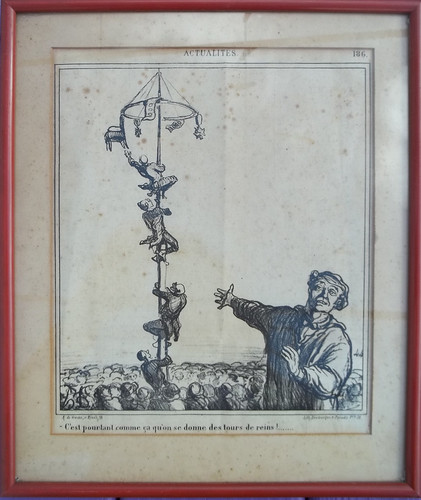
"C'est pourtant comme ça qu'on se donne des tours de reins!....... "
From Le Charivari August 28, 1868. "This is just the way to catch a strain in the back." See http://www.daumier-register.org/werkview.php?key=3658
Thoughts on Superheroes: A Never Ending Battle part 2
“Great Power, Great Responsibility” covers 1959-1977, two time periods termed by fans as the Silver and Bronze ages. The Silver Age is considered starting when DC reintroduces its Golden Age heroes such as the Flash and Green Lantern in new, science-fiction themed identities. The Bronze Age begins roughly by Jack Kirby's leaving Marvel for DC, and Stan Lee stopping writing in favor of promotion. The merging of the two periods is somewhat uneven.
Fewer key creators appear in this segment, and include Stan Lee, Neal Adams, Denny O'Neil, Len Wein, and Gerry Conway.
 Jarringly, Marvel's early 1960s books are discussed before the DC comics that made them possible. Received wisdom is that the Fantastic Four was conceived as a response to DC's success with the Justice League of America. Whether that's true or not, DC certainly reinvented the superhero before Marvel did. Instead the film opens with Marvel, switches back in time to DC and then jumps forward to 1966's camp Batman tv show. Marvel universe co-creators Jack Kirby and Steve Ditko are also given short-shrift.
Jarringly, Marvel's early 1960s books are discussed before the DC comics that made them possible. Received wisdom is that the Fantastic Four was conceived as a response to DC's success with the Justice League of America. Whether that's true or not, DC certainly reinvented the superhero before Marvel did. Instead the film opens with Marvel, switches back in time to DC and then jumps forward to 1966's camp Batman tv show. Marvel universe co-creators Jack Kirby and Steve Ditko are also given short-shrift.From there, while noting DC's comic books withering on the vine when the show is cancelled, director Michael Kantor moves on to socially relevant comics such as Marvel's introduction of the African prince the Black Panther. Unfortunately, more credit may be given to introducing characters including Luke Cage, Hero for Hire and the Panther than is deserved. But Bill Foster's commentary, as a black man reading comics, is at this point and is fun to watch, and I'll defer to his viewpoint.

 Comics slowly-growing social relevance is tracked via the use of an issue of Spider-Man to warn against drugs, even though the Comic Code Authority wouldn't approve it. DC followed that up with an issue of Green Lantern / Green Arrow by Denny O'Neil and Neal Adams that had Arrow's superhero sidekick Speedy as a heroin addict. The section on GL/GA is among the best in this segment, and includes some old film footage of the creators talking about the series at the time. Another good section is Jim Steranko's take on how he reinvigorated Nick Fury, Agent of S.H.I.E.L.D. DC's attempt to depower and do something similar with Wonder Woman is held up as a triumph of feminism, but the comic books sold miserably at the time. Her successful television show (1976-1979), and commentary by Linda Carter round this section out.
Comics slowly-growing social relevance is tracked via the use of an issue of Spider-Man to warn against drugs, even though the Comic Code Authority wouldn't approve it. DC followed that up with an issue of Green Lantern / Green Arrow by Denny O'Neil and Neal Adams that had Arrow's superhero sidekick Speedy as a heroin addict. The section on GL/GA is among the best in this segment, and includes some old film footage of the creators talking about the series at the time. Another good section is Jim Steranko's take on how he reinvigorated Nick Fury, Agent of S.H.I.E.L.D. DC's attempt to depower and do something similar with Wonder Woman is held up as a triumph of feminism, but the comic books sold miserably at the time. Her successful television show (1976-1979), and commentary by Linda Carter round this section out. Kantor then moves achronologically again, and switches to a "backlash" against sunny and optimistic superheroes while the real streets of New York are mean and gritty. The death of Spider-Man's girlfriend Gwen Stacy (1973) and the introduction of the Punisher (1974) are held up as examples. The Punisher gets more cultural significance than he deserves - as the film points out, characters such as Dirty Harry had already been successful in movies. Comic books were just following a trend, as usual. The character didn't really take off until the late 1970s when Frank Miller reworked him in Daredevil, and then he truly boomed during the 1980s grim-and-gritty years. Issues from the same year have Spider-Man driving a Spidey-mobile and fighting a hopping villain called the Kangeroo.
Kantor then moves achronologically again, and switches to a "backlash" against sunny and optimistic superheroes while the real streets of New York are mean and gritty. The death of Spider-Man's girlfriend Gwen Stacy (1973) and the introduction of the Punisher (1974) are held up as examples. The Punisher gets more cultural significance than he deserves - as the film points out, characters such as Dirty Harry had already been successful in movies. Comic books were just following a trend, as usual. The character didn't really take off until the late 1970s when Frank Miller reworked him in Daredevil, and then he truly boomed during the 1980s grim-and-gritty years. Issues from the same year have Spider-Man driving a Spidey-mobile and fighting a hopping villain called the Kangeroo.The change from newsstand sales to direct market sales in comic book stores occurred in this time period, and is arguably the most important factor in sustaining superheroes, but I don't believe it was mentioned. Overall this episode probably tries to cover too much time in a period when comic books changed a lot. I still enjoyed the show, especially the creator interviews.
All 3 parts of the documentary air locally on WETA at 8 pm on October 15th.
Images courtesy of Grand Comics Database.
Steve Niles, former local cartoonist, needs financial help
Steve Niles and his wife Monica lost just about everything they have in a flood last night due to a massive storm in Austin and have no flood insurance. A Paypal account has been set up to help them out. Steve has gone above and beyond raising $ for Hurricane Sandy relief and other tragedies and can really use some help right now. Let's pay it forward to a guy who's always been there for others.
Paypal address is HelpSteveNiles@gmail.com
Sunday, October 13, 2013
Comics in today's Post - Walking Dead returns
'The Walking Dead' Season 4: The long, sad shuffle toward Nowheresville
By Hank Stuever,
Washington Post October 13 2013
http://www.washingtonpost.com/entertainment/tv/the-walking-dead-season-4-the-long-sad-shuffle-toward-nowheresville/2013/10/10/3879a02e-2f57-11e3-9ccc-2252bdb14df5_story.html
What a Trip: A fairy godmother works her magic [online as: A magical time at Disneyland]
Elizabeth Blosser
Washington Post October 13 2013, p. F2
http://www.washingtonpost.com/lifestyle/travel/what-a-trip-a-magical-time-at-disneyland/2013/10/10/6b80501c-2d31-11e3-8ade-a1f23cda135e_story.html
Washington Post October 13 2013, p. EZ8
Thoughts on Superheroes: A Never-Ending Battle part 1
Part one, Truth, Justice and The American Way covers 1938 through 1958. The film opens with comic book dealer Vincent Zurzolo locking a copy of Action Comics #1 in a vault. Action #1 famously was the first appearance of Superman, and now is generally thought to be worth millions of dollars (I believe issues tend to be traded, and not paid for in cash).
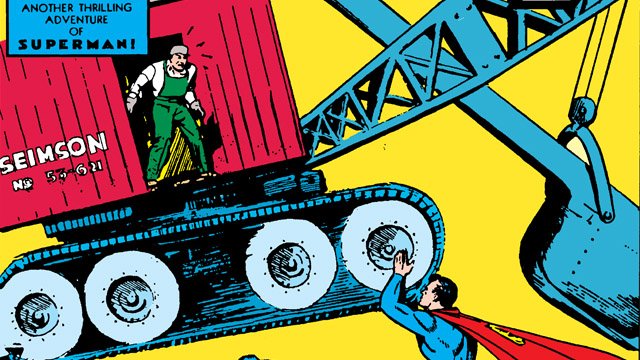
Kantor does a good job showing how Jerry Siegel and Joe Shuster started a new genre and jumpstarted an industry with Superman. As with many documentaries, commentators are talking heads in studio settings, but Kantor got a great bunch of cartoonists - Joe Kubert, Jerry Robinson, Carmine Infantino, Neal Adams, former DC publisher Jeanette Kahn, Stan Lee, Joe Simon, Jim Steranko, Ramon Fradon (a rare woman in the early superhero industry, she now appears regularly at the annual Baltimore Comic-Con), Denny O'Neil and others. Poignantly, several of these have passed on within the past few years including Kubert, Robinson, Infantino and Simon. Deceased creators such as Jack Kirby and Bill Gaines are shown in film clips, although Kirby is given short shrift in this episode, presumably because he will feature so largely in the second episode on Marvel Comics.
Most of the commentary is edited down to reflect a standard history of superhero comic books, but highlights emerge such as Fradon's talking about hiding behind her drawing board as ethnic jokes flared, or when Simon talks about drawing a big explosion in a Captain America comic book just to fill up the page faster. Irwin Hasen, who began in comic books, but made it big in the strips with Dondi, says the work "... was like a shirt factory."
The film moves onto Batman, whom Jerry Robinson clearly says Bill Finger co-created with Bob Kane, lingers on Robin and the problem of sidekicks, and then moves on to the largely-forgotten Captain Marvel (aka Shazam). Grant Morrison interestingly points out Marvel's appeal as a non-realistic based character who fought dragons and tossed comets into the sun.
%20DC%20Comics%201946__640x360_q85.jpg?0.7470127153360167)
A brief look at merchandising, still so very central to the success of comic books, focuses on Superman's radio and tv show. Kantor then moves onto World War II, Captain America and the wild success of patriotic heroes. Wonder Woman is lumped in this group, due to her star-spangled outfit and December 1941 publication date. She's also discussed as "the superheroine American had been waiting for" which may be also be on a foundation that's a bit shaky.
The film wraps up with the post-war bust in superheroes, the emergence of crime and horror comics (and briefly-mentioned westerns and romance), and the campaign against comic books spurred by Fredric Wertham and his book The Seduction of the Innocent.
All 3-parts of the documentary air locally on WETA at 8 pm on October 15th.
Oct 22: Kal at Atomic Books in Balitmore
Plus he'll showcase the work he has created specially for the Raven Brewery's Poe line of beers.
Kal will also be signing copies of his new major retrospective Daggers Drawn: 35 Years of Kal Cartoons in The Economist.
Be sure to come early... Kal Draws a good crowd and a good pint!
And Peabody Heights will be bringing a cask of their new beer, called "The Cask."
Saturday, October 12, 2013
March cartoonists discuss their book
October 2013
TeachingBooks.net http://forum.teachingbooks.net/?p=11370
Got my Kevin Rechin books today
Friday, October 11, 2013
The Post's ‘Escape From Tomorrow’ movie review
'Escape From Tomorrow' movie review
By Michael O'Sullivan,
Washington Post October 11 2013
http://www.washingtonpost.com/goingoutguide/movies/escape-from-tomorrow-movie-review/2013/10/09/96677c00-2d37-11e3-8ade-a1f23cda135e_story.html
Oct. 12: Qrissy workshop at Art Enables
(YouTube is not making it easy to post Qrissy's video, so please go here to check out.)
Oct. 11, 12: MacAuley at Artisphere














